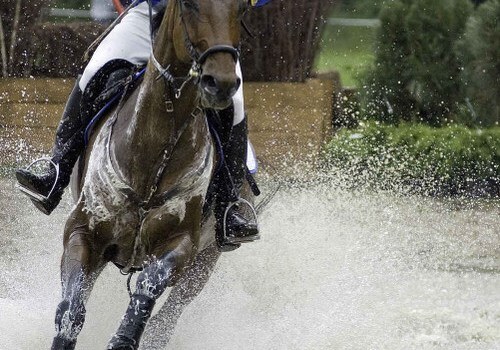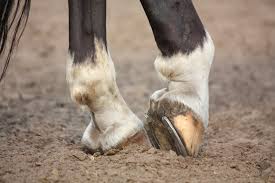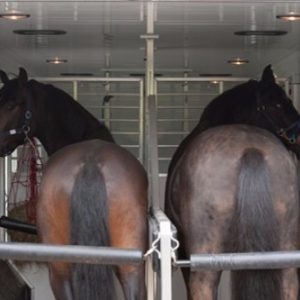A horse can drink 35 – litres of water each day, but the actual amount required is determined by a number of factors including the duration and intensity of exercise; the weather, temperature, and humidity; the horse’s fitness, body condition, ability to sweat, and hari coat; and the amount and nature of the diet. Horses generally sweat to regulate body temperature, but in hot and humid conditions, sweat no longer evaporates, and it becomes an inefficient method of cooling. Heat produced by metabolism and exercising muscle exceeds the capacity for dissipation through evaporation, and it accumulates, increasing core body temperature, sometimes dangerously. Horses develop clinical signs of heat stress and even life-threatening heat stroke.
As evaporative cooling from the skin fails, core body temperature increases. In early stages, when temperature is only slighty elevated (just over 39.5ºC), horses will appear lethargic, lack impulsion, and you might have to encourage them to maintain gait or speed. Muscle cell function is impaired and damage occurs. Respiratory rate increases to below off heat, just as in a panting dog, and they may take longer than normal to recover after exercise stops. Heart rates may be elevated, and recovery to resting heart rate will be delayed. In the early stages of heat stress, horses will fail to perform at their best, and their recovery will be prolonged.
If a mild heat-stress condition is allowed to progress and body temperature climbs to critical levels, above 40ºC, gut motility stops, and signs of colic become evident. Heart rate can exceed 100 beats per minute, and arrhythmias are common. Horses can become wobbly and collapse. This is obviously an emergency situation, and immediate veterinary attention is needed. Intravenous administration of fluid and electrolytes will be required, and there is no guarantee that the outcome will be positive. Preventing heat stress, or at least identifying and addressing the condition in its very early stages, is therefore, critical.
For horses stabled in hot, humid conditions or those in transport, one of the earliest signs that they are struggling to regulate their temperature is loss of appetite. As core temperature increases, peripheral vessels are dilated to help increase heat loss through the skin. You can often see vessels standing out on the neck and chest at these times. In order to maintain this peripheral blood pressure, fluid is drawn from the lumen of the gut into the blood stream, and vessels supplying the intestinal walls are constricted. Digestion slows and horses lose their appetite. When this occurs, it is vitally important that horses drink well to replace sweat losses and to replenish fluid volumes in the blood stream and gut lumen.
HORSE WORKING, TRAVELLING, OR STABLED IN HOT, HUMID CONDITIONS DON’T ALWAYS DRINK ENOUGH.
The two main things that stimulate thirst are a drop in blood volume and a rise in sodium concentration. Horses, though, lose quite a bit of electrolytes in their sweat, so as they lose fluid, they may also lose enough sodium to keep the concentration of sodium in their blood reasonably stable. Without the increase in sodium concentration, they don’t get a clear signal to drink. In addition, horses have a number of behavioural issues that may stop them from drinking. They can be particular about the flavour or temperature of water, and in some environments, horses may just be too excited or stressed to drink.
HOW TO PREVENT DEHYDRATION AND ELECTROLYTE IMBALANCE.
When horses are travelling and exercising, digesta in the GI tract provides an important reservoir for fluid and electrolytes. A single flake of soaked hay can hold as much as 4-5L of water, and grass is already 90% moisture, so both are worthwhile parts of the pre-travel or pre-endurance race diet. Providing oral electrolytes that help maintain normal sodium levels, before and after travel or exercise, will also be important. As electrolytes added to feed may reduce feed consumption, a paste might be a more reliable delivery method.
Electrolytes added to feed and water have been shown to potentially reduce intake, and the last thing you want to do is reduce water intake when horses are dehydrated. Always offer a bucket of plain, clean water in addition to any treated water provided, to ensure picky horses will at least have something they will be willing to drink. A small amount of blackstrap molasses can be mixed in to electrolyte-treated water for flavouring. (Add it until you get a weak-tea colour.) Many horses like the sweet molasses flavour, so you can use this trick anytime you want to encourage horses to drink larger amounts or just to camouflage the taste of different waters encountered when traveling. Once they are drinking and replacing electrolyte losses, they will generally go back to eating too.
You must be careful, though, not to introduce large concentrations of sodium chloride into the gut when horses are already hot and aren’t drinking. The osmotic draw from salt draws fluid back into the lumen of the gut, reducing fluid in the vasculature and further reducing heat dissipation through the skin. Provide slightly lower but safer doses of electrolytes along with clean, fresh water to encourage drinking.
Hay and grass, along with grains, provide some potassium, calcium, phosphorus, chloride, and magnesium, but sodium levels are generally too low for all but resting horses. In studies looking at electrolyte changes in standardbred racehorses, resting, training, and racing, results demonstrated significant changes in potassium levels and lesser changes in sodium levels. A syringe of Pro-Dosa BOOST contains potassium, sodium, and chloride in ratios that reflect those findings. The levels of electrolytes included in Pro-Dosa BOOST are appropriate for most types of horses in work and travelling, including thoroughbred racehorses and sport horses involved in most pursuits. Endurance horses, on the other hand, often have more significant changes in sodium, chloride, calcium, and magnesium levels than other equine athletes, owing to the extended period of time they are racing and the large amount of sweat produced. For this reason, it is a good idea to provide sodium chloride (table salt) to endurance horses at a rate of about 30 g or 2 tablespoons per loop, in addition to a syringe of Pro-Dosa BOOST, which already contains good doses of potassium, calcium, and magnesium.
Providing your horse with optimal nutritional support for exercise, travel, and competition is critical for the maintenance of normal appetite and thirst, in turn required to sustain hydration and replace electrolytes lost through sweat.
Pro-Dosa BOOST contains significant doses of nutrients that help to support normal appetite and thirst including the following;

*Electrolytes, including calcium, magnesium, and phosphorus, as well as sodium, potassium, and chloride. These macro-minerals help to maintain normal thirst, hydration and the electrolyte balance necessary for muscle cell, cardiac, and nerve function.
*B Vitamins, which are needed in balance with each other for normal energy production, red blood cell formation, nerve cell function, and appetite;
*22 Amino Acids, that help support thirst in the dehydrated horse as well as providing the building blocks for protein synthesis, involved in muscle recovery and growth; and
*Trace Elements, including Copper, Iron, Manganese, and Zinc, important for red blood cell formation and general metabolism.
The body needs a full complement of nutrients in careful balance to achieve optimum health, performance and recovery.
Giving your horse one tube of Pro-Dosa BOOST at least two hours before loading them on the float will help them arrive at your destination in the best possible condition and ready for the competition ahead. Give an additional tube each day of competition, and for endurance horses, give a full tube between each loop, along with an additional tablespoon of ordinary table salt when it is hot and humid. Remember to sponge or hose hot horses with cool water, scraping them frequently until they have cooled, and keep them in the shade. Encourage them to drink by keeping them relaxed and providing fresh and tasty water. Feed soaked hay or grass, when possible, to provide extra water and electrolyte reserves.



